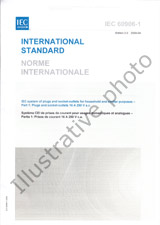We need your consent to use the individual data so that you can see information about your interests, among other things. Click "OK" to give your consent.

IEC/IEEE 62704-4-ed.1.0
Determining the peak spatial-average specific absorption rate (SAR) in the human body from wireless communication devices, 30 MHz to 6 GHz - Part 4: General requirements for using the finite element method for SAR calculations
Translate name
STANDARD published on 20.10.2020
The information about the standard:
Designation standards: IEC/IEEE 62704-4-ed.1.0
Publication date standards: 20.10.2020
SKU: NS-1008649
The number of pages: 99
Approximate weight : 328 g (0.72 lbs)
Country: International technical standard
Category: Technical standards IEC
The category - similar standards:
Annotation of standard text IEC/IEEE 62704-4-ed.1.0 :
IEC/IEEE 62704-4:2020 describes the concepts, techniques, and limitations of the finite element method (FEM) and specifies models and procedures for verification, validation and uncertainty assessment for the FEM when used for determining the peak spatial-average specific absorption rate (psSAR) in phantoms or anatomical models. It recommends and provides guidance on the modelling of wireless communication devices, and provides benchmark data for simulating the SAR in such phantoms or models. This document does not recommend specific SAR limits because these are found elsewhere (e.g. in IEEE Std C95.1 or in the guidelines published by the International Commission on Non-Ionizing Radiation Protection (ICNIRP)). This publication is published as an IEC/IEEE Dual Logo standard. IEC/IEEE 62704-4:2020 decrit les concepts, techniques et limitations de la methode des elements finis (FEM – finite-element method) et specifie les modeles et procedures de verification, de validation et devaluation de lincertitude de cette methode FEM lorsquelle est utilisee pour determiner le debit dabsorption specifique maximal moyenne (psSAR) dans les fantomes ou les modeles anatomiques. Le present document recommande et donne des recommandations en matiere de modelisation des dispositifs de communications sans fil, et fournit les donnees de reference pour la simulation du DAS dans ce type de fantomes ou de modeles. Le present document ne recommande aucune limite de DAS particuliere etant donne quelles sont definies dans dautres normes (dans la norme IEEE C95.1 ou dans les lignes directrices publiees par lICNIRP (International Commission on Non-Ionizing Radiation Protection – Commission internationale sur la protection contre les rayonnements non ionisants) par exemple). Cette publication est publiee sous la forme d’une norme IEC/IEEE Dual Logo.
We recommend:
Technical standards updating
Do you want to make sure you use only the valid technical standards?
We can offer you a solution which will provide you a monthly overview concerning the updating of standards which you use.
Would you like to know more? Look at this page.



 Cookies
Cookies
